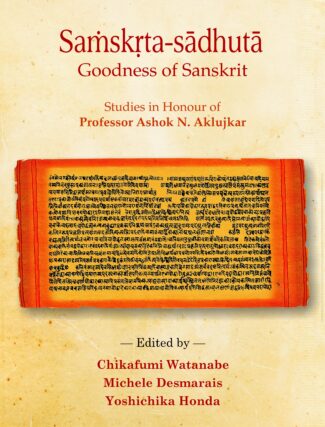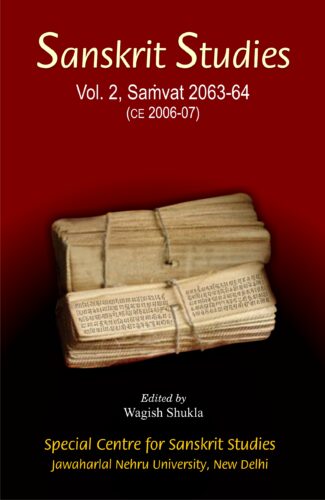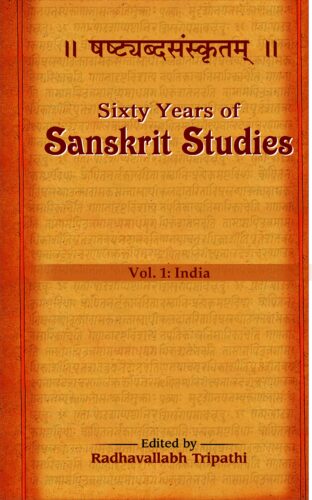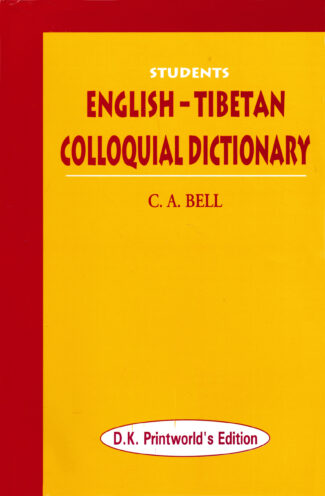Showing 37–48 of 62 results

This book, felicitating Professor Ashok Aklujkar, throws light on the major areas of Sanskrit and related subjects, such as philosophy, religion, linguistics, poetics, art and sociology. It primarily contains essays exploring the complexities of Sanskrit grammars, Indic linguistic philosophy and the relation between Sanskrit and Pali.
Making any valuable and original contribution to the treasure troves of knowledge and world literature based on serious studies, deep thought, extensive research, intensive literary discourses and experience gained through continued exposure and involvement, is not everybody’s forte. It is for such literary acumen, intrinsic scholastic qualities and other personal attributes that make Dr. Ashok Aklujkar stand out and be regarded as the world-renowned Sanskrit scholar of the modern times in whose honour and appreciation this volume has been compiled and published.
Several leading and gifted scholars from across the world have contributed a wide range of interesting research articles for this special volume that deal with major areas of Sanskrit and related studies such as philosophy, religion, linguistics, poetics, art and sociology. As a befitting tribute to the scholarly interests and attainments, reflected in the published works of Prof. Aklujkar, essays exploring the complexities in Sanskrit grammars and Indic linguistic philosophy take the centre stage in this volume. Good care has also been taken to devote sufficient space to the poetics and the inherent relation between Sanskrit and Pali Þ the two other important areas Prof. Aklujkar has focussed on, from time to time.
In this compendium of assorted and absorbing articles authored by quite senior and well-known scholars of repute, appear alongside an equal number of articles from new generation, young scholars of merit, wherein they have attempted to offer the fruits of their original and critical research work.
The result: a panorama of interesting readings that introduce the reader to the unique diversity and richness of Indology from various vantage points.

This volume ranges over logic, grammar, philosophy, environment, aesthetics, interpretation, science, epic-poetry, India’s cultural presence in Asia, and maintenance of texts, and as such should interest students, researchers and teachers of languages, literature, sciences and philosophy.
The educated Indian mind of today is, by and large, subjugated by the contemporary ethnographic, conflict-oriented, divisive thought and ideologies of the West. This can be corrected only by the thought structure in the Sanskrit intellectual texts. Two learned Supreme Court judges noted in 1993 the people of India have always held in high esteem the cultural heritage of this ancient land. And learning of Sanskrit is undoubtedly necessary for protection of this heritage. And the 1986 education policy said, Efforts will be made to delve into India’s ancient fund of knowledge and to relate it to contemporary reality. This effort will imply the development of facilities for the intensive study of Sanskrit. With this in mind, JNU set up in 2002 the Special Centre for Sanskrit Studies to examine and relate Indian thought systems both to the contemporary Indian reality and the contemporary Western thinking. A research journal/publication is integral to this vision. This volume is the first issue and it promises a continuous commitment to Indian thought, its validity and value. We hope that this effort shall build a team of young scholars with a commitment to exact Indian scholarship. This book ranges over logic, grammar, philosophy, environment, aesthetics, interpretation, science, epic-poetry, India’s cultural presence in Asia, and maintenance of texts, and as such should interest students, researchers and teachers of languages, literature, sciences and philosophy. We would like the readers to enjoy this first volume. We welcome comments, observations, responses and also invite contributions for the next volume in the series.

This is a second volume brought out by the Special Centre for Sanskrit Studies, JNU. It’s a collection of scholarly writings that throws light on ancient cultural heritage of India, marked by the Sanskrit intellectual traditions, dealing with schools of Vedas like Niruktas and the Itihasas, and the pre-Harappan Rgveda.
The cultural heritage of India is marked by the Sanskrit intellectual tradition whose flowering resulted in rich literature and development of philosophy, art and the sciences. Sanskrit Studies vol. 2 is the second issue showcasing the rich ancient heritage of Sanskrit brought out by the Centre. This volume is a collection of articles that throws light on various aspects of the Sanskrit tradition. The scholarly writings deal with schools of interpretation of the Vedas like the Niruktas and the Itihasas and evidences and arguments for a pre-Harappan date of composition for the Rigveda. They examine atomistic doctrines in Indian thought tradition, the charms and spells that constitute the Atharvaveda, the place of the Hindu women vis-a-vis ancient Indian society and traditions, and the philosophy and the aesthetics of rasa. Throughout they cite ancient Indian epics and mythologies, religious thoughts, literary works, philosophical traditions and scientific achievements to carry out a thorough and comprehensive study of the subject. There is an interesting article on issues involved in comparative studies of philosophies of two different traditions, as of the East and the West. The volume will appeal to students, teachers and scholars of Indology.

This book, the third volume in the Sanskrit Studies Series of JNU, addresses varied topics of Sanskrit studies such as the Theory of Oral Composition of Veda, Hermeneutics of the Upanisads, Concept of Dharma, Aesthetic Universe of Natyasastra, the Cultural Geography of Kalidasa, Sanskrit Commentary, Archaeoastronomy, Universal Premise in Early Nyaya, among others.
This anthology (2013-14) is the third volume of the Sanskrit Studies, a serial publication from the Special Centre for Sanskrit Studies, Jawaharlal Nehru University (JNU). The first volume of the series was published in 2004-05, and the second in 2006-07. JNU is committed to bring out this serial publication, though with some interval.
This Sanskrit Studies series is set to focus on a vast range of Sanskrit language and literature, grammar and historical linguistics, sources of history and systems of philosophy, principles of poetics and details of dramaturgy, lexicography, and so on. It also aims to bring forth the vision of Vedic texts and the varieties of Vedic traditions, Buddhist canons, Pali texts, different versions of Prakrt language and the emerging field of computational linguistics, thus adopting a multi-disciplinary approach.
This volume too deliberates on varied topics of Sanskrit studies and discusses the theory of Oral Ccomposition of Veda, the Yajusha Hautra Dispute, Hermeneutics of the Upanisads, Concept of Dharma, Aesthetic Universe of Natyasastra, the Cultural Geography of Kalidasa, Sanskrit Commentary, Archaeoastronomy, Universal Premise in Early Nyaya, Sanskrit and Tamil Interrelation, among others.
The fifteen articles presented in this volume represent the richness and rigour of Sanskrit studies in contemporary times across the globe. It should interest all those who are in Sanskrit studies researchers, teachers, students and scholars alike.

This fourth volume in Sanskrit Studies from JNU encompasses a vast range of Sanskrit disciplines including language, literature, grammar and philosophy of Sanskrit, and related disciplines like Pali, Prakrit and Apabhramsha studies, both traditional and modern subjects, showcasing the profound views of erudite scholars from India and abroad.
The fourth volume of Sanskrit studies (2015) is a consecutive publication of the Special Centre for Sanskrit Studies, Jawaharlal Nehru University. This publication from JNU is intended to throw the light on vast range of Sanskrit studies such as language and literature of Sanskrit, Grammar and linguistics, Vedanta and other ancient Indian Philosophies, Poetics, Dramaturgy, Historiography of Vedic Age, Purana and Dharmashastra, etc.
This anthology presents the profound views of experienced and young scholars from India and abroad. It addresses both traditional and modern systems prevailed in the area of Sanskrit Studies. Sanskrit is the source of great inspiration and treasure house of various knowledge systems. Its literature has spread the universal brotherhood and sustainable human relations in the world. Therefore Special Centre for Sanskrit Studies determined to bring out this publication in the field of Sanskrit Studies on vast range of Sanskrit disciplines which cover not only Language, Literature, Grammar and Philosophy of Sanskrit, but also the related disciplines such as Pali, Prakrit and Apabhramsha studies.
The seventeen articles in this volume fourteen in English and three in Sanskrit cover topics such as Champa in the Global Vision of Classical India; Kashmirs Contribution to Sanskrit Literature; Concept of Nirvikalpaka and Savikalpaka; Reconstructing Abhiramamani; Legend of King Nimi and Uttarakanda of Valmiki Ramayana; A Dense Definition of Rupaka; Abduction and Marriage in Ithihasa and Purana; Problem of Iron in Rigvedic Society; Ancient Indian Methodology of Authoring Textbooks; Bana: A Histographer; Vedantadarshne Brahmasvarupam; among others.

Sarada script has a pride of place among the Indian scripts. Though an alphabet of Kashmir par exellence, it remained for several centuries a popular script of north-western India and an extensive area around it. This book deals with the development of this script and its descendants, the Devasesaa and Takari scripts.
Among the Indian scripts the Sharada script has a pride of place. Though an alphabet of Kashmir par excellence it remained for several centuries a popular script of an extensive area of north-western India including Afghanistan, Gandhara or north-western Pakistan, the Darad territories of Gilgit, Chilas and Chitral, Ladakh, Jammu, Himachal Pradesh and Delhi. The epigraphic and literary records written in the Sharada script that have surfaced in these regions have thrown welcome light on many facets of the history and culture of the area of their provenance. Nearly the entire extant manuscripts of Sanskrit works including those on science, mathematics and erotics besides some old Kashmiri texts are written in this script. The Sharada alphabet was replaced in the 13th century by its descendant, the Devashesha, which in turn gave rise to the modern alphabet of Takari. The epigraphic, literary and other valuable documents of Himachal Pradesh available are mostly written in Devashesha and Takari. But it is sad that the number of scholars having a sound knowledge of the Sharada and Takari scripts is extremely small. There is every apprehension of the complete loss of these two scripts unless serious measures are taken to disseminate the knowledge under the guidance of the epigraphy stalwart to our younger generation of scholars. The entire study of the present work is based on original records and is comprehensively illustrated by palaeographic tables and charts prepared from published facsimilies, photographs, and original inscriptions and manuscripts. To give an idea of the records written in these two scripts, printed photographs of the inscriptions, manuscripts, documents, etc. have been given at the end of the book. It is hoped that the book would serve as a guide and an aid for the scholars interested in the study of the important and valuable records written in Sharada and Takari scripts which are otherwise preserved in museums and libraries in India and abroad.
The experiences and knowledge from our past are recorded in manuscripts which have been handed down to us over several thousand years. The Government of India, through the Department of Culture, took note of the importance of this vast tangible heritage and, in order to preserve and conserve as well as to make access to this wealth easy, established the National Mission for Manuscripts (NMM). In order to disseminate the knowledge content of manuscripts, the Mission has taken up several programmes such as lectures, seminars, and workshops. The Mission publishes the proceedings of the above-said programmes under the following series: “Samrakshika” (on conservation), “Tattvabodha” (comprising lectures based on manuscripts delivered by eminent scholars), Samikshika” (research-oriented papers presented in the seminars), and “Kritibodha” (transcribed and edited texts prepared at advanced level manuscriptology workshops conducted by NMM).
NMM has taken up a project for publishing rare and unpublished manuscripts in three forms: (a) facsimile, (b) critical edition with annotation, and (c) critical edition with translation. This series has been named as “Prakashika”.
This critically edited volume of the Shivajnanabodhabhashyam is a commentary by Shivagrayogin, an acclaimed authority on Shaiva Siddhanta, on the Shivajnanabodham of Meykandadeva, another great exponent of Shaivaism. It is the most authentic, canonical and methodical work on Shaiva Siddhanta. It stands as a mark of classical scholasticism in the Indian philosophical system. It is 39 in the Prakashika Series.

The volume aims at sharpening the skills of translating the Sanskrit philosophical texts so as to retain fundamental concreteness, basic dynamics and original flavour. The volume particularly highlights the use and significance of prefixes in the backdrop of leading Indian philosophical texts.
This volume attempts to present a dynamic approach to translating Sanskrit philosophical texts while emphasizing on keeping certain principles in mind when rendering Sanskrit philosophical texts such as: the fundamental concreteness, the basic dynamics, the resultant ambiguity and the necessary congruence of the term in question with the specific context in which it is introduced. In this context, it particularly throws light on the use and significance of prefixes, particularly of propositions used as prefixes, in Sanskrit philosophical terminology. It also examines the basic problem in dealing with prefixes; their relation to the verbal roots to which they are attached. It studies the philosophical texts of various leading schools and systems including Vedanta, Mimamsa, Samkhya, Yoga, Nyaya, Vaisesika, Buddhism and Jainism, to examine the compound-terms in them and the mental operations which are grammatically and philosophically expressed. Study of the variation of terms brought about by the application of prefixes is intended. It argues that the prefixes throw into relief, by the different modes of their application, the specific bent of the systems themselves. They have retained the motional and emotional significance, which they apparently once had, at the earliest stage. The book also takes up some vital questions, such as, whether the prefix or the noun is the essential bearer of the meaning.
The volume is a well-researched study of the use of language in Sanskrit philosophical texts. It will prove useful to scholars and students of Indology, particularly those concerned with Sanskrit language and philosophy.

The individual papers published in this compendium present a comprehensive view of the status and trends of Sanskrit studies in India and related developments over the last sixty years. This state-wise systematic presentation covers various aspects of Sanskrit teaching, research and publications as also the diverse initiatives taken by the state governments, etc. for promotion of Sanskrit Studies in the recent past.
Sanskrit was born and nurtured in India and in course of time became the mother of many languages worldwide besides a host of regional languages, it continues to be a source of inspiration, treasure trove of knowledge and a symbol of universal brotherhood. These virtues of the great language need to be taken good care of.
There is hardly any region or district in India where Sanskrit is not studied in some form or the other. This volume 1 of Sixty Years of Sanskrit Studies presents a comprehensive view of the status and trends of Sanskrit studies in India (volume II takes up the scenario of Sanskrit studies in some other countries of the world). It is a compilation of expert papers that survey the state of Sanskrit studies in the different states/union territories of the country in a systematic manner.
The individual papers begin with an analysis of the position of the Sanskrit language in the states of India. They cover various aspects of teaching, spread of popularity, research and publications in Sanskrit language and literature. They also deal with the Sanskrit academies established by the state governments and discuss the Indological research journals being brought out by various academies and institutes as also journals in the Sanskrit language. Scholars herein explore attempts made at investigating the inter-relationship of Sanskrit with medieval literatures in other languages or the regional literatures. They particularly focus on grammar, epic literature, Sanskrit religious and secular literature besides the manuscripts of other kinds. They also examine the evolution of great centres of Vedic studies in India, such as Pune, and attempts made to rediscover the corpus of the lost sàkhàs and later Vedic texts.
This volume will immensely interest students and scholars of Sanskrit studies and Indology who are keen to know about the present status of the Sanskrit language and literature in India.

While covering the status of Sanskrit studies in 13 countries across the world and bringing forth the challenges the ancient language faces, the articles by the leading international scholars contained in the book urge for understanding the future of Sanskrit studies in the larger context of human culture and as a cementing force in bringing together diverse cultures and civilizations.
With the popularity of Orientalism in the eighteenth and nineteenth centuries, knowledge of Sanskrit in the Western world led to the emergence of new schools and disciplines for study like, comparative mythology, comparative religion and comparative linguistics, etc. The articles presented in this volume examine the state of Sanskrit studies in universities in different countries of the world (volume 1 presents a survey of Sanskrit studies in universities and institutes in the states/union territories of India).
Covering some 13 countries, the articles herein discuss how some departments, related to the study of religions, in countries like the US have incorporated Sanskrit even as some other universities as those in the UK, US and other parts of the world, have Sanskrit as one of the subjects under other departments. They emphasise the fact that it is not possible to view Sanskrit as an autonomous discipline, providing authenticity to various other branches of learning, but that it has to be considered as a part of the larger framework of the global studies. They point to the emergence of new schools and centres for studies of Sanskrit in various countries. At the same time, they also examine the alarming situation arising because of the erosion or marginalisation of Sanskrit across the world, especially as some Sanskrit departments in reputed universities or institutions of higher learning, are being closed one after the other. They urge for understanding the future of Sanskrit studies in the larger context of human culture while underlining the importance of Sanskrit as a cementing force in bringing together diverse civilisations and cultures.

The book makes it explicit on how certain important philosophical questions generated from logic are, in the ultimate analysis, rooted in the area of philosophy of language. It also suggests certain means of settling these issues of philosophy of logic.
Philosophy of logic and philosophy of language are closely interrelated areas of research. Many of the philosophical questions arising from logic cannot be fully addressed without taking into consideration certain issues associated with the concerned language. The philosophical issues, e.g. concerning validity of an argument, proof for the validity of an argument are philosophical problems, which are generated from the study of logic.
The book makes it explicit on how certain important philosophical questions generated from logic are, in the ultimate analysis, rooted in the area of philosophy of language. It also suggests certain means of settling these issues of philosophy of logic. In addition to certain issues in philosophy of logic the book extensively deals with certain issues in philosophy of language such as the issue concerning holism, semantic inferentialism, realism, objectivity of statements and representationalism.
Those who are engaged in advanced research in philosophy of language and philosophy of logic will benefit immensely from reading this book. It will also be of great use to the students of philosophy and to the general readers as well.

The Dictionary containing more than eleven thousand words including honorific words, is a practical handbook that attempts to provide a quick yet thorough understanding of the colloquial Tibetan language. It presents Tibetan words in romanised form for pronunciation by those who do not understand Tibetan.
The Dictionary is a practical handbook that attempts to provide a quick yet thorough understanding of the colloquial Tibetan language. A special feature of the Dictionary containing more than eleven thousand words including honorific words, is that the Tibetan words are presented in romanised form for pronunciation by those who do not understand Tibetan. An introductory chapter details the structure and system of pronunciation of Tibetan letters and words. It combines an easy approach with incorporation of features like two or more Tibetan words against the same English equivalent and the literary form in the Tibetan character, with the colloquial form in the romanised Tibetan, when the colloquial and Tibetan forms differ from each other to some extent. All this is to aid in a deeper knowledge of the subject. A special feature of this edition is that all the corrections listed in the errata of the second edition have been carried out in the main text. The volume will be particularly useful to scholars of Tibetan language and English-speaking students learning the language.
| There are no products |